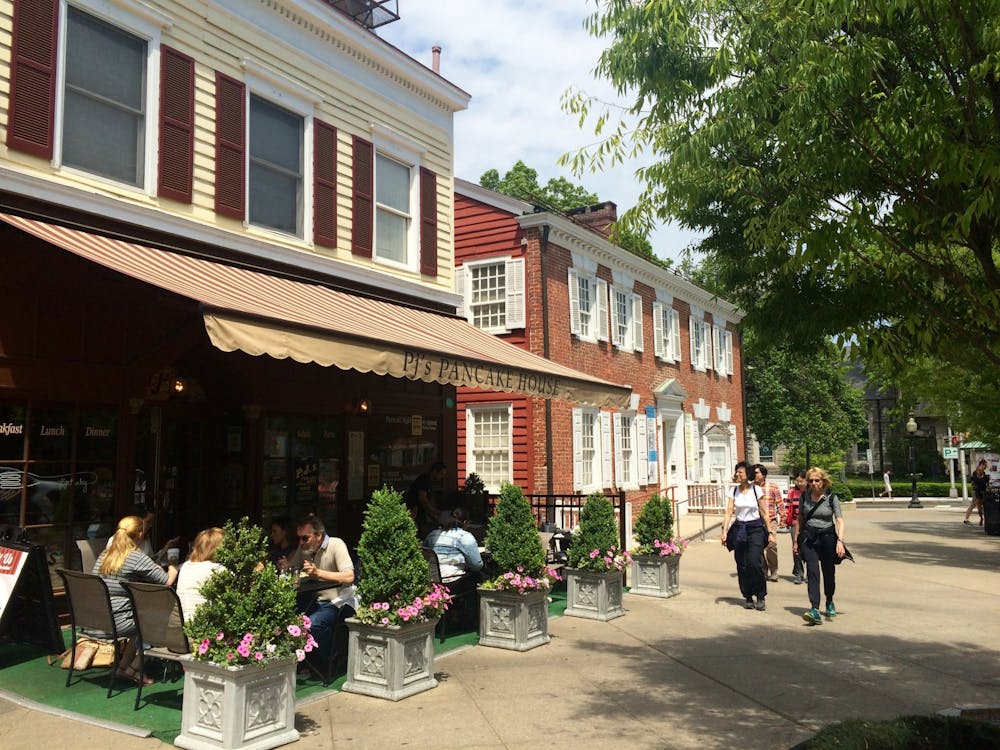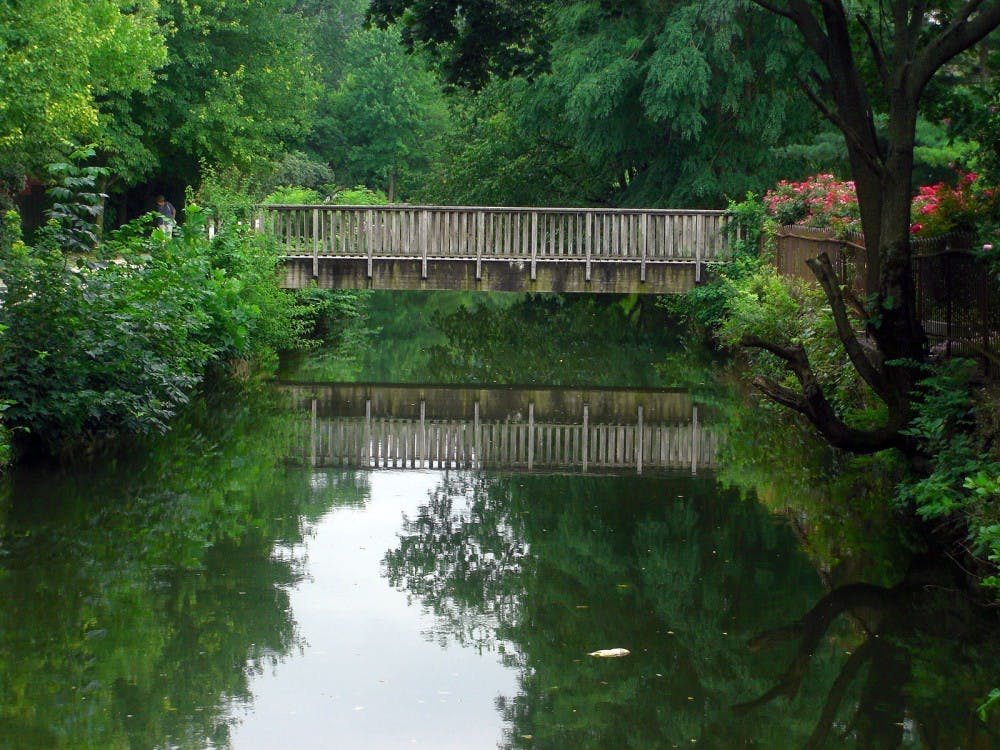On the walls of the Frist campus center a quote in large grey letters reads, "No life is well-rounded without the subtle inspiration of beauty. — Beatrix Farrand." The words wrap awkwardly around the corner, easily overlooked. Most students probably haven't heard of Beatrix Farrand. Yet it is this time of year — as the flowering trees on campus spill into bloom — when they most appreciate her legacy.
The ruffle of white blossoms on the tall Kobus magnolias in Prospect Garden, for example. The dashes of pink slowly infusing the colorless Spelman apartments. The prepubescent gravity of old limbs heavy with new buds, stretching across Pyne Courtyard. The slippery crush of petals already accumulating, faintly, underfoot.
Trees are blooming this week across the University campus, and Beatrix Farrand is just one of the hands that have made Princeton such a well-planted campus. One of the foremost landscape architects of the early 20th century, Farrand served as consulting architect to the University from 1913 to 1943. Niece to Edith Wharton and wife of Max Farrand class of 1892, she was also one of the founders of the American Landscape Architects Association in 1899, although she called herself a "landscape gardener" because that was a more acceptable profession for a woman. Her work across the country includes the Dumbarton Oaks Estate outside of Washington D.C. and the Yale University campus.
The influence of Farrand's style, which emphasizes the lines of the buildings, especially using espalier — the technique of planting trees against the base of a building and training them to grow along the wall — is still felt on the campus. A particularly beautiful Farrand original is the pair of saucer magnolias espaliered against Dickinson Hall on the East side of McCosh Courtyard, which curve toward each other at the top of the building.
Buildings she worked on included the Graduate College, Baker Rink, the Boathouse, Cuyler Hall, Class of 1901 Hall, Dickinson Hall, Foulke Hall, Jones Hall, and the Frick Laboratory. Her love for working on campuses was partially a philosophical choice. "We all know education is by no means a mere matter of books, and that aesthetic environment contributes as much to mental growth as facts assimilated from a printed page," Farrand wrote in the Princeton Alumni Weekly on June 9, 1926. James Consolloy, manager of the University grounds, says that Farrand's touch is something that subsequent landscape architects have tried to maintain. He points out the two Japanese Weeping Cherries that stand sentinel on either side of the second entryway to Henry Hall. There's a picture that was taken of that same entryway in 1926, he said, and it looked about the same as it does now. The original weeping cherry trees died about ten years ago and were replaced, and the current trees are about the same age as those in the picture.
"It's not hard to copy an architect," he says, "I copy. I think it's important to do that," he says, pointing out that if someone does something creative, you just want to keep it.
Princeton's magnolia trees seem to be a case in point. In the 1920's, Farrand first planted Kobus magnolias, some of which are still around, like the two trees with white blooms South of McCosh infirmary. The Kobus is native to Japan, and Farrand probably got those first plants from the Arnold Arboretum in Boston, which was then run by Farrand's mentor Charles Sprague Seargent, said Consolloy.
Farrand also espaliered a Southern Magnolia against the Southwest corner of Pyne that is now the largest in New Jersey. The Southern magnolia, a plantation Icon famous for its shiny leaves and huge white blossoms, doesn't usually do well in this climate, but the tree on the corner of Pyne happened to be planted right above a steam tunnel, explained Consolloy.

Other varieties of magnolias survive without heating aids, although the buds are easily burned by early frosts. This year has been kinder to the flowers than the last two years, when many buds burned. Temperatures this spring haven't been terribly warm, but the early-blooming kobus and star magnolias have had only one mild frost. Prospects are also looking good for the future of the saucer magnolia blooms opening this week.
"Usually by the fifteenth [of April] is the top of their season," Consolloy said, referring to the Saucer magnolias. "But we've been having all this cold weather which has slowed things down, which is kind of nice because it prolongs the bloom time."
Consolloy explained that most species of magnolia found on campus are native to parts of East Asia where spring Is more gradual than in New Jersey. Despite climactic deficiencies, New Jersey does have one surprising benefit for the magnolias — acid rain.
"They are somewhat acid-loving plants," said Consolloy, who was a grower for 15 years before coming to the University. He pointed out that magnolias like the change in pH levels that accompanies the pollutants in the prevailing West wind.

The University boasts eight distinct types of magnolias, ranging from the native Sweetbay along Elm Drive, to the more exotic Anise (Dodge-Osborne), or Cucumber (South of West College). Many of the more rare varieties bloom later In the summer, after students leave campus. Consolloy estimates that he plants about a dozen new magnolias each year to replace those that are getting old.
"It's fun to buy them because there are so many different varieties," he said, mentioning a yellow magnolia recently planted In front of Frick that he particularly liked.
While magnolias are popular on college campuses along the East Coast, there are a few things about Princeton — besides the acid rain — that set it apart.
"They just grow very well here," said John Kuser '46, a professor emeritus of foresty at Cook College, Rutgers and a longtime Princeton resident. "Jim Consol-loy and his predecessors have taken good advantage of that."
"The one advantage Princeton has, of course, is age. Some of our plants are pretty old," said Consolloy. "We'll move plants around a lot. One of the things I enjoy most Is having the budget to do that."
Students on campus seem equally appreciate of the cheery blooms that signal spring. "We've been waiting all winter for these things to come out," said Carlee Mal-emute '04. The windows of her Spelman apartment look out over Saucer magnolias that are just now blooming, and she says they make her realize how soon graduation is.
"Springtime is like witnessing the hand of God," said Khalil Sullivan '04, who also lives In a Spelman room with a magnolia view. "It makes you feel all young and fresh again . . . like a midsummer night's eve, perhaps."
His roommate Ben Weber '04 says he likes magnolia trees because he played under them as a child, and during his first years here he studied under the Mathey courtyard magnolias. "I guess we've spent a lot of time under magnolia trees," Weber reflected.
Many graduating seniors associate magnolias with the duration of the time at Princeton. "I especially like that row of magnolias coming up from the Dinky," said Jacob Mikanowski '04. "As a prefrosh that's the first thing I saw." Now, four years later, he brings a magnolia blossom to his girlfriend.







